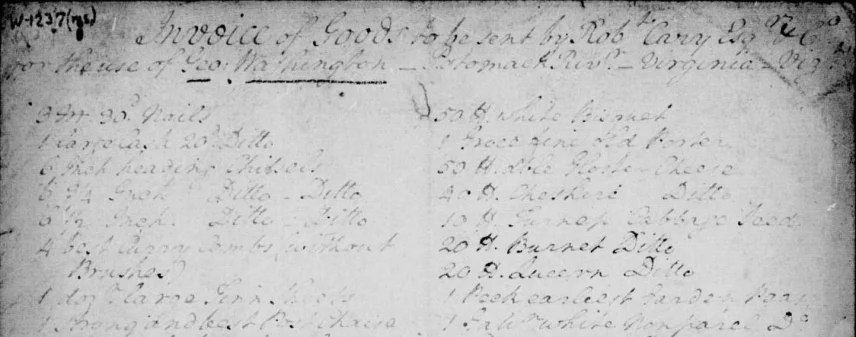by Mary V. Thompson
As the holiday gift-giving season approaches, I’ve been spending a fair amount of time in the evening shopping online for just the right present for various members of my family. The other day, it became obvious that I wasn’t the only one, when a colleague emailed to express frustration with having to pay shipping and handling fees and then asked whether George Washington had to pay such things, two hundred years ago. The answer, as you might imagine, is yes, he did.
Let’s start by looking at an invoice that was sent to George Washington by his British agents, the firm of Robert Cary and Company. Washington would ship agricultural products from Mount Vernon to that company in England, where those commodities would be sold. Proceeds from the sales were used by Cary and Company to purchase manufactured products and luxury goods requested by Washington from British stores and craftsmen and send them back by ship to Mount Vernon. See the invoice, dated December 3, 1771 here.
One of the first things you might notice is that the invoice is quite varied in regard to the kinds of things being purchased by the Washingtons. The family was acquiring tools; dishes and flatware for the table; chamber pots; medicines; foods (Double Gloucester and Cheshire cheeses, French olives, pickled walnuts, capers, mustard, and spices); books; shoes; clothing; playing cards; jewelry and watches; mill stones; fabric; blankets; building materials; seines and fishing equipment; saddles and horse equipage. You might also notice that the list includes the names of quite a few merchants, each being recorded in the middle of the page, with the goods they supplied enumerated below. Each entry details the amount or numbers of each type of object being shipped, sometimes with a fairly good description, along with the price for each unit and, on the far right, the total cost of that line item.
 Another thing you might notice are references, usually at the head of each type of article, but sometimes below, as to how these goods were packed and just how much that packaging cost. Today when we make a purchase, the invoice or sales receipt doesn’t usually reveal how much was paid for the impossible-to-remove clear plastic packaging which can leave bleeding wounds if taken off incorrectly, or the cardboard box and tube into which 5.5 ounces of.toothpaste were inserted. The Cary & Company invoice, for example, shows that the British firm headed by Eleanor Brown supplied George Washington with 10 groce of corks at 2 shillings per groce, for a total cost of £1; the 1,440 corks were packed in a bag valued at an additional 6 pence.
Another thing you might notice are references, usually at the head of each type of article, but sometimes below, as to how these goods were packed and just how much that packaging cost. Today when we make a purchase, the invoice or sales receipt doesn’t usually reveal how much was paid for the impossible-to-remove clear plastic packaging which can leave bleeding wounds if taken off incorrectly, or the cardboard box and tube into which 5.5 ounces of.toothpaste were inserted. The Cary & Company invoice, for example, shows that the British firm headed by Eleanor Brown supplied George Washington with 10 groce of corks at 2 shillings per groce, for a total cost of £1; the 1,440 corks were packed in a bag valued at an additional 6 pence.
Closer to the bottom of the invoice are various shipping and handling charges, including “entry out”; searcher fees; shipping charges; freight primage (surcharges for loading and unloading a ship) and bills of lading (documents from a carrier, showing that a cargo has been received by a shipper); literage (fees for using lighters—large, open, flat-bottomed barges—for loading & unloading ships in shallow water); commissions; and insurance premiums on the entire order, which was valued at £350.
